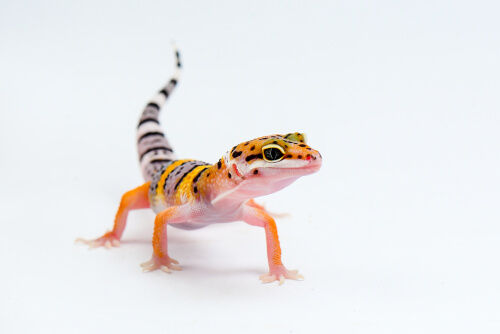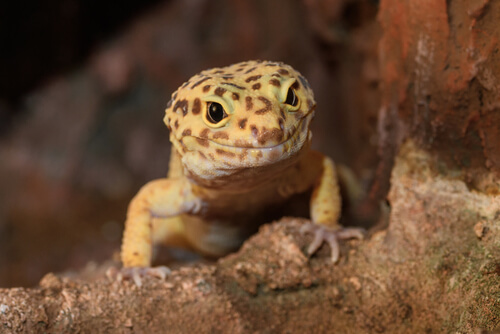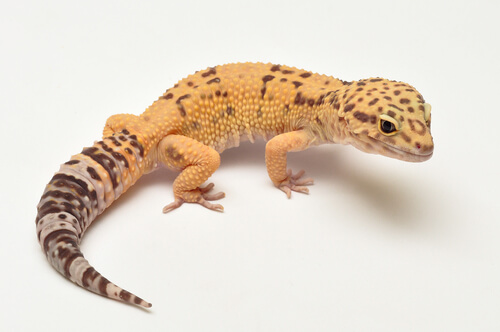
| Kingdom | Animalia |
| Phylum | Chordata |
| Class | Reptilia |
| Order | Squamata |
| Family | Eublepharidae |
| Genus | Eublepharis |
| Species | E. fuscus, E. hardwickii, E maularius |
| Niche | Ground-dwelling gecko |
| Length | 8.1 to 11 in (20.5-27.5 cm) |
| Weight | 0.11-0.14 lb (54-65 g) |
| Lifespan | 15 years |
| Social Structure | Mostly solitary |
| Conservation Status | Least Concern |
| Preferred Habitat | Rocky grasslands |
| Average Clutch Size | 2-20 per season (typically 2 at a time over a period) |
| Main Prey Species | Insects (crickets, caterpillars, etc.) |
| Predators | Snakes, lizards, foxes |
The Basics
The leopard gecko refers to three of five species of the genus Eublepharis, native to the Middle East and Asia. They prefer rocky, dry regions where they will live in grasslands, but have also become a common pet. In fact, the common leopard gecko is often referred to as the first domesticated lizard species. Along with the common leopard gecko (E. macularius), there are West Indian leopard geckos (E. fuscus) and East Indian leopard geckos (E. turcmenicus).

Physical Description
The genus Eublepharis, meaning ‘true eyelid’ in reference to their fully-functional eyelids, was first described in 1827. They are fairly small but sturdy lizards, and their common name, ‘leopard gecko’ refers to their spotted patterns, predominantly shades of yellow and brown. Their tails are long, about the same length as their torsos. Like most geckos, they can regenerate their tails when lost in evading predators. However, once lost, their new tails typically regenerate shorter and less symmetrical than their original tail.
The overall length of adults is about 8.1 to 11 in (20.5-27.5 cm) and they weigh about 0.11-0.14 lb (54-65 g). Their skin is bumpy, with particularly tough skin around their head, back, and neck. Like all reptiles, leopard geckos shed their skin periodically as they grow larger. There are subtle differences between males and females as well, but this can typically only be determined by turning the animals over and closely examining their undersides.
Range, Habitat, and Behavior
Leopard geckos occur throughout eastern and southwestern Asia as well as parts of the Middle East. They prefer rocky grasslands in these dry regions, where they will often burrow. Here, they spend their time on the ground and tend to be nocturnal to avoid the heat of the day.
Leopard geckos hunt insects at night, using their strong eyesight to ambush them as they pass. Their diet consists primarily of crickets, mealworms, and other similar insect species such as caterpillars. Some of their common predators include snakes and other large reptiles, as well as some mammals like foxes, which will also eat their eggs if given the opportunity. To avoid predation, they rely on their very good sense of hearing and sight. Their skin also works as camouflage and, of course, they can drop their tail in an attempt to get away if absolutely necessary. However, their best line of defense is to remain in their burrows, which helps them to avoid excessive heat as well.
It is not clear the degree to which leopard geckos interact with other members of its species, but they do congregate to mate. They may live in loose colonies in the wild, but likely spend most of their time alone. In captivity, they are generally kept alone.

Reproduction
In the wild, leopard geckos will mate breed during the summer months. Sperm can be stored by the females, allowing her to lay two eggs at a time over the breeding season of about one month, in which she will lay up to 20 eggs.
The first egg is typically laid about 3-4 weeks after copulation. Depending on various factors such as temperature and humidity, the eggs require about 30-90 days of incubation time before the young will hatch. Each baby gecko hatches at about 2.6 to 3.3 in (6.5 to 8.5 cm) in length and weighing just 0.10 Oz (3 g) and is completely independent from the moment it is born onward.
Like other reptiles, leopard gecko exhibit temperature-dependent sex determination in their young. That is, the sex of their eggs will be determined by the conditions in which they incubate. More females will be produced in cooler temperatures, around 79-84°F (26-29°C) whereas in warmer temperatures (93-95°F or 34-35°C) where more male offspring are produced. It is believed that the determination of sex occurs within the first two weeks after an egg is laid.
Fun Facts about Leopard Gecko!
Leopard geckos are beautiful and relatively docile lizards. They are not dangerous or venomous, nor are they large. It may be for these reasons that they have become such common pets, or it may be for all the fascinating characteristics they exhibit.
Unstuck
Unlike their other gecko cousins, they are unable to climb well. Along with their body shape and size, this is mostly due to their lack of adhesive lamellae on their feet and toes that are present in other species often seen clinging to walls and other smooth vertical surfaces.

Half Asleep
It is a common misconception that leopard geckos enjoy particularly hot, dry conditions. This may be due to their range, which occurs throughout many notoriously hot regions of the world such as Afghanistan. However, it may be said that the leopard gecko lives here despite the heat, not because of it.
The leopard gecko tends to inhabit some of the coolest parts of this range, opting for rocky grasslands over desert plains. However, this has its drawbacks as well for the gecko. During the winter, conditions in these habitats can become near-freezing, which forces them to move into their burrows and enter a state of semi-hibernation known as ‘brumation’. Brumation is effectively the cold-blooded animal’s version of hibernation but utilizes a distinct metabolic process than the hibernations undertaken by animals such as bears and squirrels.
Prior to brumation, the leopard gecko will eat more than normal to increase its fat reserves. Once it becomes necessarily cold, they will enter their burrow, where they will go months without food. Sometimes, they will wake up occasionally to drink some water, especially if temperatures temporarily increase. Unlike mammals that hibernate for a relatively fixed period regardless of the temperature fluctuations throughout the winter, brumating animals are directly impacted by ambient temperatures in their environment.
Truly Common
The common gecko is a common pet, with over 3 million captive individuals bred in the United States. Indeed, it has been referred to as the first domesticated lizard. In addition, the ‘domesticated’ animals tend to have more brilliant color morphs than wild animals. This is due mostly to selective breeding of the species, much like has occurred historically in dogs and other common domestic animals.
